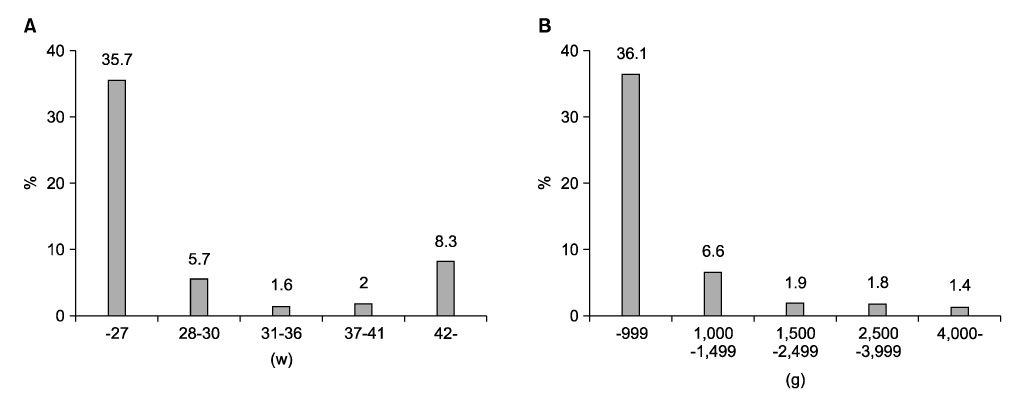Chonnam Med J.
2011 Apr;47(1):31-38. 10.4068/cmj.2011.47.1.31.
Analysis of High-Risk Infant Births and Their Mortality: Ten Years' Data from Chonnam National University Hospital
- Affiliations
-
- 1Department of Pediatrics, Chonnam National University Medical School, Gwangju, Korea. yychoi@jnu.ac.kr
- 2Department of Obstetrics and Gynecology, Chonnam National University Medical School, Gwangju, Korea.
- KMID: 2172242
- DOI: http://doi.org/10.4068/cmj.2011.47.1.31
Abstract
- Prematurity and low birth weight are major factors associated with neonatal morbidity and mortality, and their incidence is not decreasing despite an annual decrease in the total number of live births in Korea. The objective of this study was to establish a strategy to reduce neonatal mortality by analyzing the clinical characteristics of high-risk infant births along with their mortality and causes of death. We retrospectively surveyed the medical records of infants born at Chonnam National University Hospital and of patients admitted to the neonatal intensive care unit (NICU) for 10 years from October 1999 to December 2008. Premature and low birth weight infants were almost half of the live births, and their NICU admission rate increased with increases in the numbers of outborns and multiples. Also, their mortality decreased dramatically over the past 10 years. About 60% of deaths occurred within 1 week of life, and the causes of death were mostly related to prematurity. Perinatal asphyxia was the major cause of death in infants less than 1 week old, whereas sepsis was the major cause after 4 weeks of age. The major cause of death was sepsis in premature or low birth weight infants and perinatal asphyxia in term or normal weight infants. The major cause of death was sepsis in inborns and perinatal asphyxia in outborns. Our results suggest that medical personnel training for immediate postnatal care including neonatal resuscitation, infection control, and a systematic team approach to regionalization are all needed to reduce the mortality rate.
Keyword
MeSH Terms
Figure
Reference
-
1. Kim BI, Choi JH, Yun CK, Park JD, Choi CW, Choi JW, et al. Statistical study of extremely low birth weight (ELBW) infants. Korean J Perinatol. 1998. 9:3–12.2. Kim JT, Park HK, Jun NL, Lim JW, Kim EA, Kim KS, et al. Recent outcome of extremely low birth weight infants at Asan Medical Center. J Korean Soc Neonatol. 2003. 10:133–142.3. Kook JH, Kim SH, Kim MJ, Song ES, Choi YY. The changes of rate and mortality of low birth weight infants andIts relating factors-past 25 years in Chonnam University Hospital. Chonnam Med J. 2007. 43:181–190.4. Park MR, Lee BS, Kim EA, Kim KS, Pi SY. Outcomes of extremely low birth weight infants at the Asan Medical Center between 2003 and 2006. J Korean Soc Neonatol. 2008. 15:123–133.5. Statistics Korea. http://kostat.go.kr/portal/korea/index.action.6. Park DK, Kil CH, Bae CW. Neonatal statistics of Korea in 2002: collective results of live-births, and neonatal mortality rates from 62 Hospitals. J Korean Soc Neonatol. 2004. 11:122–129.7. Bae CW, Kim MH, Chun CS, Lee C, Moon SJ, Yoo BH, et al. Neonatal statistics of Korea in 1996: collective results of live-births , neonatal mortality , and incidence of dischage against medical advice at 64 hospitals. J Korean Soc Neonatol. 1997. 4:153–169.8. Kim YO, Kim SH, Cho CY, Choi YY, Kook JH, Hwang TJ. Changes in incidence, survival rate and morbidity of very low birth weight infants. J Korean Pediatr Soc. 2003. 46:769–776.9. Bae CW, Kim KS, Kim BI, Shin SM, Lee SL, Lim BK, et al. Patient distribution and hospital admission costs in neonatal intensive care units: collective study of 7 hospitals in Korea during 2006. J Korean Soc Neonatol. 2009. 16:25–35.10. Health Insurance Review & Assessment Service 2008. http://www.hira.or.kr/intro.jsp.11. Korean Statistical Information Service 2008. http://www.kosis.kr.12. Park SE, Jeon GW, Choi CW, Hwang JH, Koo SH, Kim YJ, et al. Evaluation of perinatal and management factors associated with improved survival in extremely low birth weight infants. Korean J Pediatr. 2005. 48:1324–1329.13. Chang YS, Kim YJ, Koo SH, Lee JH, Hwang JH, Choi CW, et al. Outcomes and management of fetal infants with birth weight below 500 g at a tertiary center. Korean J Pediatr. 2005. 48:939–945.
- Full Text Links
- Actions
-
Cited
- CITED
-
- Close
- Share
- Similar articles
-
- Changes in Neonatal Epidemiology during the Last 3 Decades in Korea
- Maternal, infant, and perinatal mortality statistics and trends in Korea between 2018 and 2020
- Perinata Mortality Rate: III Comparaative Studies Among 3-Hospitals
- The Changes of Rate and Mortality of Low Birth Weight Infants andIts Relating Factors-Past 25 Years in Chonnam University Hospital
- Infant, maternal, and perinatal mortality statistics in the Republic of Korea, 2014



